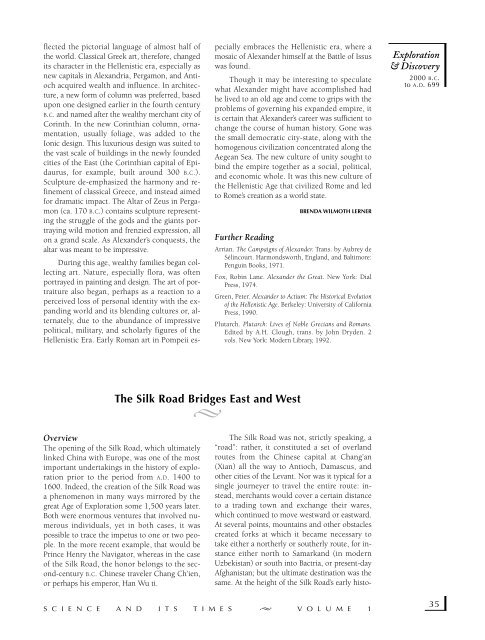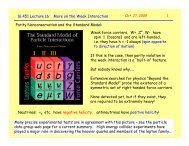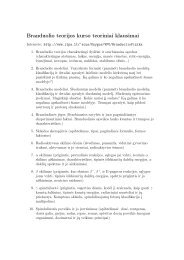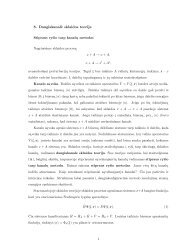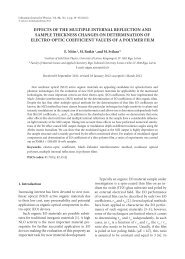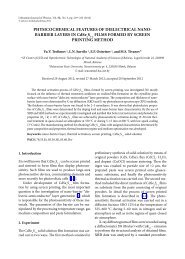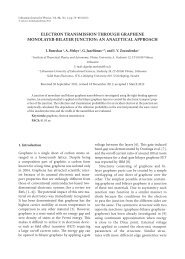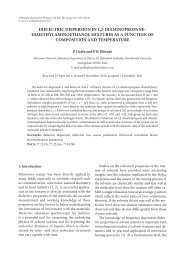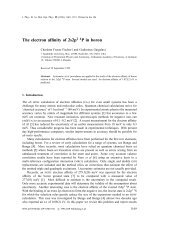Gale - Science and Its Times Vol 01 (2000 BC to AD 699).pdf
Gale - Science and Its Times Vol 01 (2000 BC to AD 699).pdf
Gale - Science and Its Times Vol 01 (2000 BC to AD 699).pdf
Create successful ePaper yourself
Turn your PDF publications into a flip-book with our unique Google optimized e-Paper software.
flected the pic<strong>to</strong>rial language of almost half of<br />
the world. Classical Greek art, therefore, changed<br />
its character in the Hellenistic era, especially as<br />
new capitals in Alex<strong>and</strong>ria, Pergamon, <strong>and</strong> Antioch<br />
acquired wealth <strong>and</strong> influence. In architecture,<br />
a new form of column was preferred, based<br />
upon one designed earlier in the fourth century<br />
B.C. <strong>and</strong> named after the wealthy merchant city of<br />
Corinth. In the new Corinthian column, ornamentation,<br />
usually foliage, was added <strong>to</strong> the<br />
Ionic design. This luxurious design was suited <strong>to</strong><br />
the vast scale of buildings in the newly founded<br />
cities of the East (the Corinthian capital of Epidaurus,<br />
for example, built around 300 B.C.).<br />
Sculpture de-emphasized the harmony <strong>and</strong> refinement<br />
of classical Greece, <strong>and</strong> instead aimed<br />
for dramatic impact. The Altar of Zeus in Pergamon<br />
(ca. 170 B.C.) contains sculpture representing<br />
the struggle of the gods <strong>and</strong> the giants portraying<br />
wild motion <strong>and</strong> frenzied expression, all<br />
on a gr<strong>and</strong> scale. As Alex<strong>and</strong>er’s conquests, the<br />
altar was meant <strong>to</strong> be impressive.<br />
During this age, wealthy families began collecting<br />
art. Nature, especially flora, was often<br />
portrayed in painting <strong>and</strong> design. The art of portraiture<br />
also began, perhaps as a reaction <strong>to</strong> a<br />
perceived loss of personal identity with the exp<strong>and</strong>ing<br />
world <strong>and</strong> its blending cultures or, alternately,<br />
due <strong>to</strong> the abundance of impressive<br />
political, military, <strong>and</strong> scholarly figures of the<br />
Hellenistic Era. Early Roman art in Pompeii es-<br />
The Silk Road was not, strictly speaking, a<br />
“road”: rather, it constituted a set of overl<strong>and</strong><br />
routes from the Chinese capital at Chang’an<br />
(Xian) all the way <strong>to</strong> Antioch, Damascus, <strong>and</strong><br />
other cities of the Levant. Nor was it typical for a<br />
single journeyer <strong>to</strong> travel the entire route: instead,<br />
merchants would cover a certain distance<br />
<strong>to</strong> a trading <strong>to</strong>wn <strong>and</strong> exchange their wares,<br />
which continued <strong>to</strong> move westward or eastward.<br />
At several points, mountains <strong>and</strong> other obstacles<br />
created forks at which it became necessary <strong>to</strong><br />
take either a northerly or southerly route, for instance<br />
either north <strong>to</strong> Samark<strong>and</strong> (in modern<br />
Uzbekistan) or south in<strong>to</strong> Bactria, or present-day<br />
Afghanistan; but the ultimate destination was the<br />
same. At the height of the Silk Road’s early his<strong>to</strong>pecially<br />
embraces the Hellenistic era, where a<br />
mosaic of Alex<strong>and</strong>er himself at the Battle of Issus<br />
was found.<br />
Though it may be interesting <strong>to</strong> speculate<br />
what Alex<strong>and</strong>er might have accomplished had<br />
he lived <strong>to</strong> an old age <strong>and</strong> come <strong>to</strong> grips with the<br />
problems of governing his exp<strong>and</strong>ed empire, it<br />
is certain that Alex<strong>and</strong>er’s career was sufficient <strong>to</strong><br />
change the course of human his<strong>to</strong>ry. Gone was<br />
the small democratic city-state, along with the<br />
homogenous civilization concentrated along the<br />
Aegean Sea. The new culture of unity sought <strong>to</strong><br />
bind the empire <strong>to</strong>gether as a social, political,<br />
<strong>and</strong> economic whole. It was this new culture of<br />
the Hellenistic Age that civilized Rome <strong>and</strong> led<br />
<strong>to</strong> Rome’s creation as a world state.<br />
Further Reading<br />
BRENDA WILMOTH LERNER<br />
Arrian. The Campaigns of Alex<strong>and</strong>er. Trans. by Aubrey de<br />
Sélincourt. Harmondsworth, Engl<strong>and</strong>, <strong>and</strong> Baltimore:<br />
Penguin Books, 1971.<br />
Fox, Robin Lane. Alex<strong>and</strong>er the Great. New York: Dial<br />
Press, 1974.<br />
Green, Peter. Alex<strong>and</strong>er <strong>to</strong> Actium: The His<strong>to</strong>rical Evolution<br />
of the Hellenistic Age. Berkeley: University of California<br />
Press, 1990.<br />
Plutarch. Plutarch: Lives of Noble Grecians <strong>and</strong> Romans.<br />
Edited by A.H. Clough, trans. by John Dryden. 2<br />
vols. New York: Modern Library, 1992.<br />
Exploration<br />
& Discovery<br />
<strong>2000</strong> B.C.<br />
<strong>to</strong> A.D. <strong>699</strong><br />
The Silk Road Bridges East <strong>and</strong> West<br />
<br />
Overview<br />
The opening of the Silk Road, which ultimately<br />
linked China with Europe, was one of the most<br />
important undertakings in the his<strong>to</strong>ry of exploration<br />
prior <strong>to</strong> the period from A.D. 1400 <strong>to</strong><br />
1600. Indeed, the creation of the Silk Road was<br />
a phenomenon in many ways mirrored by the<br />
great Age of Exploration some 1,500 years later.<br />
Both were enormous ventures that involved numerous<br />
individuals, yet in both cases, it was<br />
possible <strong>to</strong> trace the impetus <strong>to</strong> one or two people.<br />
In the more recent example, that would be<br />
Prince Henry the Naviga<strong>to</strong>r, whereas in the case<br />
of the Silk Road, the honor belongs <strong>to</strong> the second-century<br />
B.C. Chinese traveler Chang Ch’ien,<br />
or perhaps his emperor, Han Wu ti.<br />
S C I E N C E A N D I T S T I M E S V O L U M E 1<br />
35


